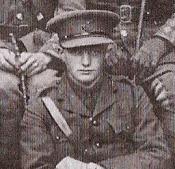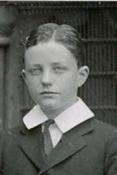
|
The King's School Canterbury |
Roll of Honour |
| Lieutenant Derrick OSBORNE | |
|
2nd Battalion Durham Light Infantry Date of birth: 9th December 1897 Date of death: 21st March 1918 Killed in action aged 20 Commemorated on the Arras Memorial Bay 8 |

|
| He was born at Folkestone on the 9th of December 1897, the second son of Sir Francis Osborne, 15th Baronet, a gentleman, and Lady Kathleen Eliza (nee Whitfield) of Framfield Grange, Uckfield, Sussex. He was educated at Ascham St Vincent's Prep School near Eastbourne, Sussex, at St Clare School, Walmer, Kent and at the King's School Canterbury from January 1912 to March 1915, gaining his Rugby First XV colours as a forward in 1914/15 season. The Cantuarian wrote the following of his rugby in 1915:- "Not showy but is always doing good work. Tackles and saves well." In April 1915 he entered the Royal Military College Sandhurst and was commissioned as a 2nd Lieutenant in the Durham Light Infantry in 1916. He embarked for France on the 16th of September 1916 where he joined the 2nd Battalion in the field. He was promoted to Lieutenant in 1918 On the 19th of March 1918 the 2nd Battalion Durham Light Infantry marched from their billets at Beugnatre Camp and relieved the 11th Battalion Essex Regiment, taking over the front line in the Morchies sector. B and D Companies were deployed in the front trenches with A and C Companies holding the reserve trenches in support. It was widely believed that the Germans were planning a major offensive and the Durhams had been warned that this was the case. Patrols sent out into No Man's Land had found no German patrols and that freshly cut gaps in the German wire were heavily defended. At 5pm on the evening of the 20th of March a thick ground mist started to rise until 9pm when it was thick fog. The 2nd Durhams sent out patrols during the night and at 5am on the morning of the 21st they stood to in their trenches. This coincided with a terrific barrage from the German artillery which consisted largely of gas shells and fell principally on the support trenches. At 7am communications were lost with the front line as the shelling became heavier still and fell on the front lines as well. At 8.20am a message came from the front line saying that the German infantry was attacking and those in the reserve lines could see the front line area "covered with advancing Germans". By 10am the Germans were seen advancing on both of the Durham's flanks as the front line continued to hold. At 10.20am the enemy infantry advanced towards the reserve lines but were slaughtered by rifle and machinegun fire from the defenders. At 10.45am they launched another attack, using bombs to work their way up a communication trench towards battalion headquarters. This attack was forced back by the defenders who also used bombs. Having held their line for most of the day the Durhams watched as German artillery moved past their flanks towards the rear. At 3pm came an order from Corps Headquarters to retire by which time the Durhams were almost completely surrounded. After repelling another attack it was decided that it would be too dangerous to retreat in daylight and that the beleaguered men should retire after nightfall. At 7.15pm the fog returned and the order was passed down that every man should make his own way back to the Corps line. Around three hundred men from the reserve line set out under fire for the Corps line, including Derrick Osborne. He did not survive the journey; one of seven officers and around fifty men who didn't make it back. He is commemorated on the Ascham St Vincent's School memorial arch, on the memorial at All Saints Church in Eastbourne and on the village memorial at Framfield in Sussex. |
|
 | |
Back